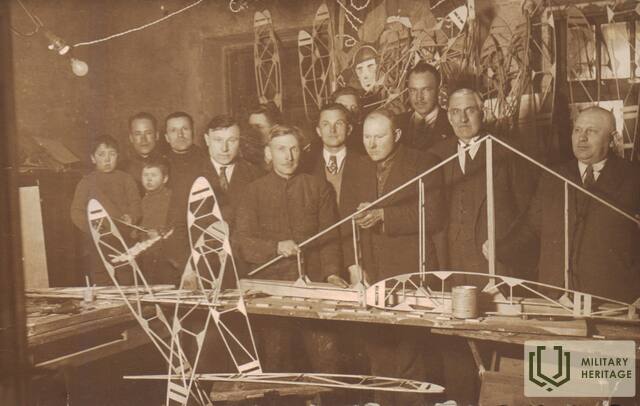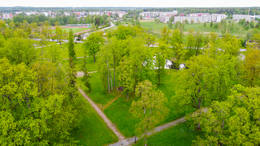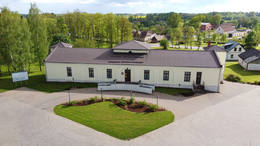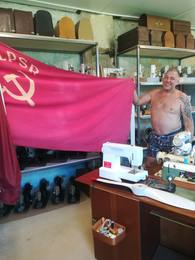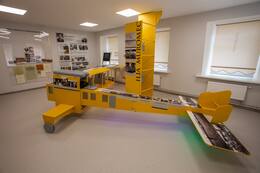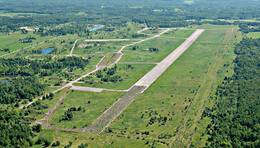Latvijos armijos aviacijos pulkas
I WW1, I Nepriklausomybės karai, Baltijos šalių nepriklausomybė, II WW2
1919 m. birželio 7 d. įsteigtas kaip Aviacijos grupė, nuo 1920 m. rugsėjo mėn. pulkas buvo žinomas kaip Aviacijos parkas, o nuo 1921 m. kovo iki 1926 m. rugsėjo mėn. – Aviacijos divizija.
1939 m. Aviacijos pulkui priklausė pulko štabas Rygoje, 8 operatyvinės eskadrilės (60 lėktuvų, 120 lakūnų ir 80 specialistų), karo aviacijos mokykla, remonto dirbtuvės ir tiekimo sandėlis. Aerodromai ir pagalbiniai aerodromai buvo Rygoje (Spilvės oro uoste), Ramavoje, Jumpravmuižoje (Rumbulos oro uostas), Koknesėje, Gulbenėje ir Krustpilyje (Krustpilio oro uostas).
Jūrų aviacijos bazės buvo Liepojoje ir Usmoje. Po Latvijos okupacijos Aviacijos pulkas buvo išformuotas 1940 12 25.
Susijusios vietos
Latvian military aviation aerodrome
Located in the territory of Vecgulbene manor - in the historical center.
In the interwar period, the garrison of the Latvian Army was located in Gulbene, where the 7th Sigulda Infantry Regiment Battalion was stationed. Aerodromes are especially important in places where important railway and road junctions have been established. In 1937, a newly established unit of the Aviation Regiment was stationed in Gulbene, which became the 6th Division of the Latgale Division Scouts, increasing the number of army units near the eastern border of Latvia.
The conservatory building is visible.
Gulbene County History and Art Museum
Located near Vecgulbene manor, Litenes street.
In the second half of the 1940s, the radar ornament of the Soviet army part No.75568 was deployed in the conservatory of Vecgulbene manor and in the adjacent manor house of the manor; In the late 1980s, they were transferred to Beļava Parish. The Soviet army left Gulbene in 1993.
There is a square with two artificial hills on Litenes Street.
Private collection of military objects and sewing machines
The only sewing machine collection in Latvia with more than 200 different sewing machines from the pre-war and Soviet periods, which played a direct role in the production of military clothing in the pre-war and war years. Collection creator - Juris Beloivans
Preiļi Museum of History and Applied Arts exhibition "Jāzeps Baško - air coachman"
It is located in Preiļi 1st primary school premises.
The exhibition "Jāzeps Baško - air driver" was created in 2014 and is dedicated to the 125th birthday of the outstanding local man, aviator, commander of the "Iļja Muromec" squadron, organizer of the Latvian Air Force, general Jāzeps Baško and the 100th anniversary of World War I. The exhibition of the museum's collection is designed as a design object - a 6-fold reduced model of the "Ilya Muromec" airplane, on which information can be found in the form of texts and images. The exhibition is enriched by deposits from the collections of the Latvian War Museum and newly acquired information from the Latvian State History Archive, the Spilve Aviation Museum and materials from the private archives of individual individuals.
Mandatory prior application by calling T. 65322731, T. 25640398. Tour in English and Russian is possible. You can go to the exhibition "Jāzeps Baško - Air Driver" from the Museum of History and Applied Arts.
Vaiņode air base
Vaiņode airfield still has 16 Soviet-era aircraft hangars and an 1800 m section of the once 2500 m long runway. The airfield can only be visited with a previous booking. Vaiņode airfield was established during the Latvian independence as one of the cradles of Latvian aviation and was later one of the largest military airfields in the Baltic States. In 1916, two hangars for German Army airships were built. Airships were used to gather intelligence and bomb the positions of the Russian Army. Later the city of Riga bought the airship hangars and used their roof structures to build the pavilions of the Riga Central Market. In May 1940, the 31st Fast Bomber Aviation Regiment of the Red Army moved to Vaiņode, and the construction of a standardized concrete slab runway began. At the end of the summer of 1944 the partially completed airfield was used by various German aviation units, however, at the end of World War II, the same airfield was used by the Red Army aviation units fighting the German Army group called ‘Kurzeme’. After World War II the Soviet Air Forces were stationed in Vaiņode until 1992.
Pagalvės oro uostas
Įsikūręs Rygoje, Pārdaugavoje, Spilvės pievose netoli Iļģuciems.
Spilvė karinio paveldo istorijoje garsėja ambicingu Spilvės mūšiu XVIII a. ir Spilvės aerodromas. Nuo XX amžiaus jis buvo naudojamas orlaivių bandymams, o Pirmojo pasaulinio karo metais tapo Latvijos aviacijos istorijos liudininku.
Pirmojo pasaulinio karo metais Spilvės pievas naudojo Rusijos kariuomenės oro pajėgos kovoje su vokiečių kariuomene. Sukūrus Latviją, aerodromas tapo svarbiausia šalies oro pajėgų baze ir pilotų poligonu. Ankstesni oro uosto pavadinimai buvo „Spilvės oro uostas“ arba „Rygos oro uostas“, vėliau „Rygos centrinis oro uostas“. Tai buvo pagrindinis oro uostas Latvijoje iki Rygos oro uosto atidarymo 1975 m.
Galbūt prie įspūdingų ne vieno Latvijos piloto pasiekimų prisidėjo prie Rygos esantis Spilvės aerodromas ir svajonė pasiekti žvaigždes. Galbūt, tačiau Latvijos aviacijos užuomazga gerokai senesnė ir ją galima rasti Priekulėje, kur latvių kalvis Zviedris savadarbiu aparatu išskrido iš bažnyčios bokšto.
Šiandien Spilvės oro uostas veikia. Galima pamatyti 1954 metais pastatytą oro uosto pastatą, kuris įkūnija sovietinį klasicizmą arba „Stalino imperijos“ stilių.
Šaltiniai:
Irbītis, K. Latvijos aviacija ir jos pradininkai. Ryga: Mokslas, 2004.
Brūvelis, E. Latvijos aviacijos istorija: 1919-1940. Ryga: Mokslas, 2003.
Oficiali valstybinės agentūros „Civilinės aviacijos agentūra“ svetainė. Prieiga: https://www.caa.gov.lv/lv/latvijas-aviacijas-vesture-isuma [žiūrėta 2021 02 22].
Susijusi istorija
Jungtinės aviacijos šventė – tikra nacionalinė šventė
Pasakotojas aprašo vieną populiariausių ir gausiai lankomų Latvijos renginių – Aviacijos šventę Spilvėje. Aprašoma šventės eiga ir apimtis. Akcentuojamas aviacijos populiarumas Latvijoje.
Rēzeknes bombardavimas 1944 m
1944 m. Velykas įvyko Rezeknės bombardavimas, dėl to buvo sugriauta didelė dalis miesto pastatų, žuvo dešimtys civilių, o dar keli tūkstančiai liko be pastogės. Žmonės, kurie savo kailiu patyrė šiuos įvykius ir gali apie juos papasakoti, tuo metu buvo tik vaikai. Vienas iš jų yra ir šios istorijos autorius.




